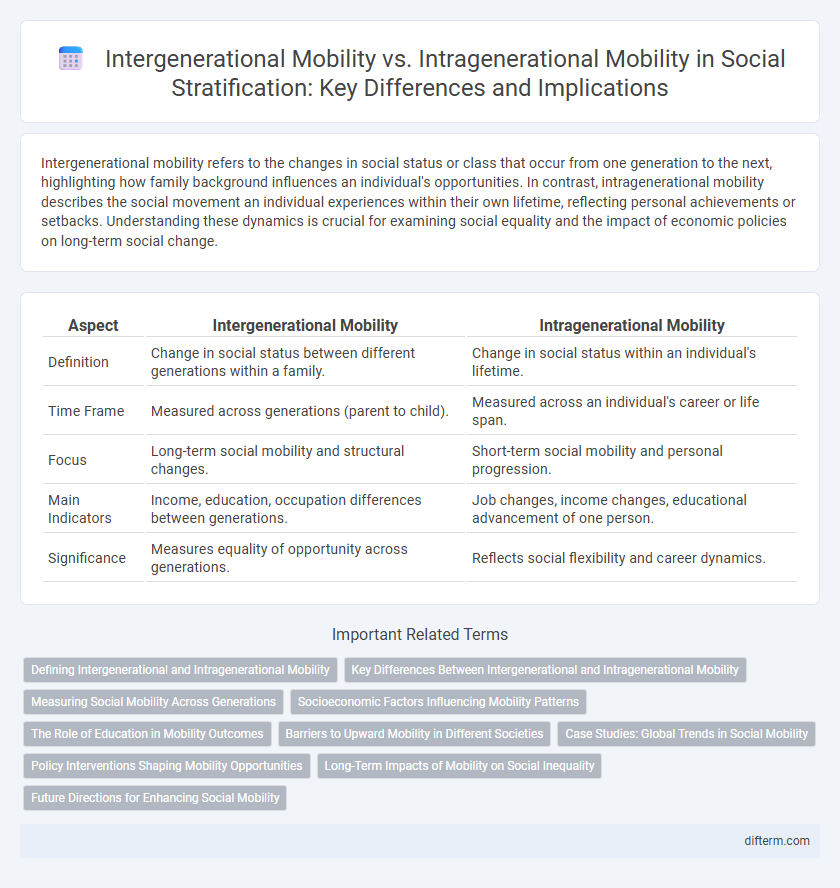Intergenerational mobility refers to the changes in social status or class that occur from one generation to the next, highlighting how family background influences an individual's opportunities. In contrast, intragenerational mobility describes the social movement an individual experiences within their own lifetime, reflecting personal achievements or setbacks. Understanding these dynamics is crucial for examining social equality and the impact of economic policies on long-term social change.
Table of Comparison
| Aspect | Intergenerational Mobility | Intragenerational Mobility |
|---|---|---|
| Definition | Change in social status between different generations within a family. | Change in social status within an individual's lifetime. |
| Time Frame | Measured across generations (parent to child). | Measured across an individual's career or life span. |
| Focus | Long-term social mobility and structural changes. | Short-term social mobility and personal progression. |
| Main Indicators | Income, education, occupation differences between generations. | Job changes, income changes, educational advancement of one person. |
| Significance | Measures equality of opportunity across generations. | Reflects social flexibility and career dynamics. |
Defining Intergenerational and Intragenerational Mobility
Intergenerational mobility refers to the changes in social status or class that occur between different generations within a family, typically measured by comparing parents' socioeconomic position to that of their children. In contrast, intragenerational mobility tracks the social movement of an individual throughout their own lifetime, reflecting career advancements, income changes, or educational achievements. Understanding these distinct mobility types helps clarify how societal structures influence both long-term familial outcomes and individual life trajectories.
Key Differences Between Intergenerational and Intragenerational Mobility
Intergenerational mobility refers to changes in social status or class between different generations within a family, highlighting how children's socioeconomic positions compare to their parents'. In contrast, intragenerational mobility measures social movement of an individual within their own lifetime, tracking changes in occupation, income, or social status. Key differences include the time frame of analysis--across generations versus within a single generation--and the focus on family legacy versus individual achievements.
Measuring Social Mobility Across Generations
Measuring social mobility across generations involves analyzing changes in socioeconomic status between parents and their adult children, capturing intergenerational mobility. Intragenerational mobility focuses on an individual's movement within their own lifetime, while intergenerational mobility reflects broader shifts in opportunities and inequalities between generations. Key metrics include income elasticity, educational attainment comparisons, and occupational status across family lines to assess long-term mobility trends.
Socioeconomic Factors Influencing Mobility Patterns
Socioeconomic factors like education access, family income, and neighborhood environment significantly influence both intergenerational and intragenerational mobility patterns. Intergenerational mobility depends heavily on parental economic status and inherited social capital, while intragenerational mobility is more affected by individual career opportunities and skill development over time. Structural inequalities such as discrimination and labor market segmentation further shape mobility trajectories within and across generations.
The Role of Education in Mobility Outcomes
Education serves as a critical driver in enhancing both intergenerational and intragenerational mobility by equipping individuals with skills and knowledge that expand economic opportunities. Higher educational attainment correlates with increased income potential and social status shifts, breaking cycles of disadvantage across generations. Access to quality education reduces structural inequalities, enabling upward mobility within a lifetime and fostering societal equity over time.
Barriers to Upward Mobility in Different Societies
Intergenerational mobility varies significantly across societies due to structural barriers such as unequal access to quality education, discriminatory labor markets, and persistent socioeconomic inequalities that limit upward mobility opportunities for younger generations. Intragenerational mobility is often constrained by limited social safety nets, rigid class systems, and wage stagnation, preventing individuals from improving their economic status within their lifetime. Societies with higher income inequality and lower social capital exhibit pronounced barriers to mobility, reinforcing cycles of poverty and restricting social advancement.
Case Studies: Global Trends in Social Mobility
Case studies on global trends reveal distinct patterns between intergenerational and intragenerational mobility, highlighting how socioeconomic status shifts across generations versus within an individual's lifetime. Research from countries like Sweden and Canada shows high intergenerational mobility linked to equitable education and labor market access, whereas intragenerational mobility varies based on economic cycles and policy changes. These case studies emphasize the importance of social policies and economic structures in shaping mobility dynamics worldwide.
Policy Interventions Shaping Mobility Opportunities
Policy interventions targeting education access and labor market regulations significantly influence both intergenerational and intragenerational mobility by reducing structural barriers and enhancing skill development. Social welfare programs, such as income support and affordable housing, stabilize economic conditions, enabling individuals to pursue upward mobility within and across generations. Investments in early childhood education and vocational training also promote equitable opportunities, fostering long-term improvements in socioeconomic mobility trajectories.
Long-Term Impacts of Mobility on Social Inequality
Intergenerational mobility refers to the changes in social status between different generations within a family, while intragenerational mobility focuses on the social movement within an individual's lifetime. High levels of intergenerational mobility can reduce long-term social inequality by enabling successive generations to access better educational and economic opportunities. In contrast, limited intragenerational mobility often indicates persistent barriers that reinforce existing social hierarchies and contribute to enduring inequality over time.
Future Directions for Enhancing Social Mobility
Future directions for enhancing social mobility emphasize policies that simultaneously address intergenerational and intragenerational mobility to reduce persistent inequalities across generations while promoting upward movement within a single lifetime. Investments in equitable education access, targeted workforce development, and social safety nets are critical for fostering environments where individuals can overcome systemic barriers to advancement. Leveraging data-driven approaches to monitor mobility trends helps tailor interventions that support both early-life opportunities and career transitions.
intergenerational mobility vs intragenerational mobility Infographic

 difterm.com
difterm.com